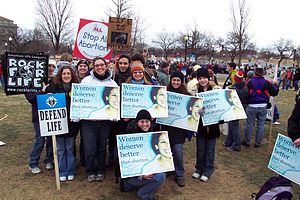
Back الحركة المناوئة للإجهاض في الولايات المتحدة Arabic Pro-life Danish جنبش حامی زندگی ایالات متحده آمریکا Persian Антиабортное движение в США Russian
 |
The United States anti-abortion movement (also called the pro-life movement or right-to-life movement) is a movement in the United States that opposes induced abortion and advocates for the protection of fetal life. Advocates support legal prohibition or restriction on ethical, moral, or religious grounds, arguing that human life begins at conception and that the human zygote, embryo or fetus is a person and therefore has a right to life. The anti-abortion movement includes a variety of organizations, with no single centralized decision-making body.[1] There are diverse arguments and rationales for the anti-abortion stance. Some allow for some permissible abortions, including therapeutic abortions, in exceptional circumstances such as incest, rape, severe fetal defects, or when the woman's health is at risk.
Before the Supreme Court 1973 decisions in Roe v. Wade and Doe v. Bolton, anti-abortion views predominated and found expression in state laws which prohibited or restricted abortions in a variety of ways. (See Abortion in the United States.) The anti-abortion movement became politically active and dedicated to the reversal of the Roe v. Wade decision, which struck down most state laws restricting abortion in the first trimester of pregnancy.[2][3] In the United States, the movement is associated with several Christian religious groups, especially the Catholic Church and Evangelical churches, and is frequently, but not exclusively, allied with the Republican Party.[4][5] The movement is also supported by secular organizations (such as Secular Pro-Life) and non-mainstream anti-abortion feminists.[6] The movement has campaigned to reverse Roe v. Wade and to promote legislative changes or constitutional amendments, such as the Human Life Amendment, that prohibit or at least broadly restrict abortion.[1]
On the other side of the abortion debate in the United States is the abortion-rights movement (also called the pro-choice movement), which argues that pregnant women should have the right to choose whether or not to have an abortion.
In June 2022, the Supreme Court overturned Roe v. Wade in Dobbs v. Jackson Women's Health Organization, ending federal abortion rights and allowing individual states to regulate their own abortion laws.[7]
- ^ a b Cite error: The named reference
Encyclopedia of women in American politicswas invoked but never defined (see the help page). - ^ Staggenborg, Suzanne (1994). The Pro-Choice Movement: Organization and Activism in the Abortion Conflict. Oxford University Press US. p. 188. ISBN 0-19-508925-1.
- ^ Greenhouse, Linda (2010). Before Roe v. Wade: Voices that Shaped the Abortion Debate Before the Supreme Court's Ruling. Kaplan Publishing. ISBN 978-1-60714-671-1. Archived from the original on January 14, 2013.
- ^ Susan Welch; John Gruhl; John Comer; Susan M. Rigdon (2009). Understanding American Government (12 ed.). Cengage Learning. p. 150. ISBN 978-0-495-56839-1.
- ^ "Democrats for Life". Democrats for Life. Retrieved November 16, 2011.
- ^ Oaks, Laury (Spring 2009). "What Are Pro-Life Feminists Doing on Campus?" (PDF). NWSA Journal. 21 (1): 178–203. doi:10.1353/ff.2009.a263661. ISSN 1040-0656. S2CID 143219631.
- ^ Mangan, Dan; Breuninger, Kevin (June 24, 2022). "Supreme Court overturns Roe v. Wade, ending 50 years of federal abortion rights". CNBC. Archived from the original on June 25, 2022. Retrieved June 24, 2022.
© MMXXIII Rich X Search. We shall prevail. All rights reserved. Rich X Search